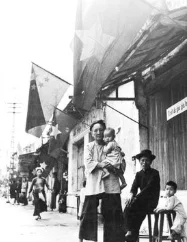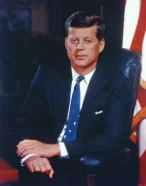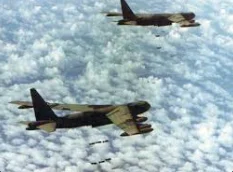-
 The U.S. did not get involved in the conflict until 1949-1950.The U.S. did not support French colonialism, but they also did not support Ho Chi Minh's communism.The two event that caused the U.S. to support France is that China becomes communists in 1949 and the Korean war.
The U.S. did not get involved in the conflict until 1949-1950.The U.S. did not support French colonialism, but they also did not support Ho Chi Minh's communism.The two event that caused the U.S. to support France is that China becomes communists in 1949 and the Korean war. -
 In a speech, U.S. President Dwight D. Eisenhower says the fall of French Indochina to communists could create a “domino” effect in Southeast Asia. This so-called domino theory guides U.S. thinking about Vietnam for the next decade.
In a speech, U.S. President Dwight D. Eisenhower says the fall of French Indochina to communists could create a “domino” effect in Southeast Asia. This so-called domino theory guides U.S. thinking about Vietnam for the next decade. -
They agreed to end the fighting between French and Vietminh.They divided Indochina into three countries Vietnam, Cambodia, and Laos.Also Vietnam was divided into two sections,Communist North and pro-Western South
-
 He was elected on November 8, 1960. Kennedy needed to appear tough on communism, so he increased aid and advisors to Vietnam. He also urged Diem to make democratic reforms to increase his popularity:These reforms had little effect.
He was elected on November 8, 1960. Kennedy needed to appear tough on communism, so he increased aid and advisors to Vietnam. He also urged Diem to make democratic reforms to increase his popularity:These reforms had little effect. -
The Anti-War Movement was heavily influenced by the civil rights Movements. Students and teachers across the US colleges abandoned their classes to discuss the Vietnam war and their opposition to it. Many young men did not want to fight in a conflict they felt in a conflict they felt was wrong so they burned draft cards to protest.
-
The Soviet Politburo increases its support to North Vietnam, sending aircraft, artillery, ammunition, small arms, radar, air defense systems, food and medical supplies. Meanwhile, China sends several engineering troops to North Vietnam to assist in building critical defense infrastructure.
-
Nearly 300 Americans are killed and hundreds more injured in the first large-scale battle of the war, the Battle of la Drang Valley. At the battle, in South Vietnam’s Central Highlands, U.S. ground troops are dropped onto and withdrawn from the battlefield by helicopter, in what would become a common strategy. Both sides declare victory.
-
The My Lai massacre was a United States war crime committed on 16 March 1968, involving the mass murder of unarmed civilians in Sơn Mỹ village, Quảng Ngãi province, South Vietnam, during the Vietnam War. I feel very bad for them they were in such a bad state and now family and friends are dying.
-
 The Tet Offensive begins, encompassing a combined assault of Viet Minh and North Vietnamese armies. Attacks are carried out in more than 100 cities and outposts across South Vietnam, including Hue and Saigon, and the U.S. Embassy is invaded. The effective, bloody attacks shock U.S. officials and mark a turning point in the war and the beginning of a gradual U.S. withdrawal from the region.
The Tet Offensive begins, encompassing a combined assault of Viet Minh and North Vietnamese armies. Attacks are carried out in more than 100 cities and outposts across South Vietnam, including Hue and Saigon, and the U.S. Embassy is invaded. The effective, bloody attacks shock U.S. officials and mark a turning point in the war and the beginning of a gradual U.S. withdrawal from the region. -
 In a series of secret bombings known as “Operation Menu,” U.S. B-52 bombers target suspected communist base camps and supply zones in Cambodia. The bombings are kept under wraps by Nixon and his administration since Cambodia is officially neutral in the war, although The New York Times would reveal the operation on May 9, 1970
In a series of secret bombings known as “Operation Menu,” U.S. B-52 bombers target suspected communist base camps and supply zones in Cambodia. The bombings are kept under wraps by Nixon and his administration since Cambodia is officially neutral in the war, although The New York Times would reveal the operation on May 9, 1970 -
 President Nixon signs the Paris Peace Accords, ending direct U.S. involvement in the Vietnam War. The North Vietnamese accept a cease fire. But as U.S. troops depart Vietnam, North Vietnamese military officials continue plotting to overtake South Vietnam.
President Nixon signs the Paris Peace Accords, ending direct U.S. involvement in the Vietnam War. The North Vietnamese accept a cease fire. But as U.S. troops depart Vietnam, North Vietnamese military officials continue plotting to overtake South Vietnam. -
 In the Fall of Saigon, the capital of South Vietnam is seized by communist forces and the government of South Vietnam surrenders. U.S. Marine and Air Force helicopters transport more than 1,000 American civilians and nearly 7,000 South Vietnamese refugees out of Saigon in an 18-hour mass evacuation effort.
In the Fall of Saigon, the capital of South Vietnam is seized by communist forces and the government of South Vietnam surrenders. U.S. Marine and Air Force helicopters transport more than 1,000 American civilians and nearly 7,000 South Vietnamese refugees out of Saigon in an 18-hour mass evacuation effort.